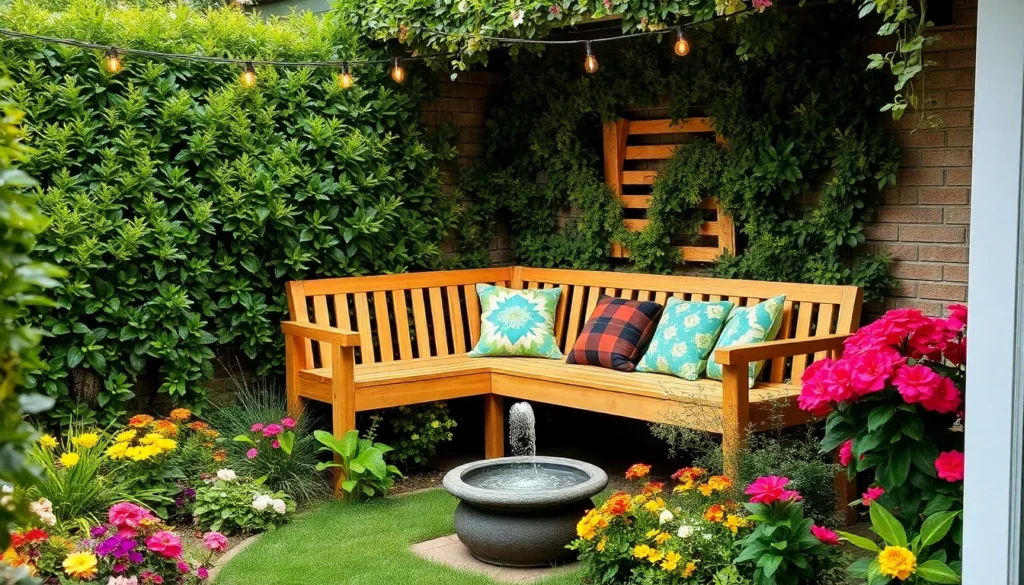We’ve all stood in our yards staring at that awkward empty corner wondering what to do with it. That forgotten space where the fence meets the shed or where two garden beds create an odd triangular patch can actually become your garden’s most stunning focal point.
Corner spaces offer unique design opportunities that straight garden beds simply can’t match. These intimate nooks naturally draw the eye and create perfect spots for dramatic plantings cozy seating areas or eye-catching garden features. Whether you’re working with a shady corner under mature trees or a sunny spot that gets full exposure all day long there’s a corner garden solution that’ll transform your space.
We’re sharing proven corner garden ideas that maximize both beauty and function while working with your space’s natural characteristics. From vertical growing answers to creative hardscaping these strategies will help you turn that neglected corner into your garden’s crown jewel.
Transform Your Corner Into a Cozy Reading Nook
We can turn any garden corner into the perfect literary escape with thoughtful design choices. Creating a peaceful reading sanctuary requires balancing comfort with weather resistance for year round enjoyment.
Choose Weather-Resistant Seating Options
Weather resistant furniture forms the foundation of our outdoor reading space. Teak benches offer natural durability and develop a beautiful silver patina over time, requiring minimal maintenance throughout the seasons. Aluminum frames with weather resistant cushions provide lightweight portability while withstanding rain and UV exposure.
Wicker chairs made from synthetic resin deliver classic comfort without the deterioration issues of natural materials. Cedar Adirondack chairs bring rustic charm and natural weather resistance, though they benefit from annual sealing to maintain their appearance. Powder coated steel options offer modern aesthetics with superior longevity, perfect for contemporary garden corners.
Storage benches serve dual purposes by housing reading materials and cushions while providing seating. Concrete benches with built in planters create permanent fixtures that blend seamlessly with garden landscapes. Recycled plastic lumber furniture mimics wood grain appearance while offering maintenance free durability for decades.
Add Soft Lighting for Evening Ambiance
Soft lighting extends our reading hours into twilight and creates magical evening atmosphere. Solar string lights draped overhead eliminate electrical concerns while providing gentle illumination that won’t strain our eyes during reading sessions. Battery powered LED lanterns offer portable answers that we can adjust based on seasonal changes or weather conditions.
Path lights positioned around the seating area create subtle ground level ambiance without overwhelming the peaceful setting. Solar stake lights with warm white LEDs blend naturally into surrounding plantings while marking the reading nook’s boundaries. Flameless candles in weather resistant holders provide flickering charm without fire safety concerns or wind interference.
Wall mounted sconces on nearby structures direct focused light exactly where we need it for comfortable reading. Solar powered spotlights hidden among plants can uplight tree canopies or architectural features, creating dramatic backdrop lighting. Rope lights wound through trellises or fencing create soft perimeter definition while maintaining the cozy atmosphere we desire.
Create Privacy With Screening Plants
Strategic screening plants transform open corners into intimate reading retreats. Bamboo varieties like clumping fountain bamboo create fast growing privacy walls that rustle gently in breezes, adding natural sound masking. Evergreen shrubs such as boxwood or privet provide year round screening while requiring minimal maintenance once established.
Climbing vines on trellises offer vertical privacy answers perfect for corner installations. Boston ivy and Virginia creeper provide seasonal color changes while creating dense coverage during growing seasons. Clematis varieties bloom at different times throughout the year, ensuring continuous visual interest alongside privacy benefits.
Ornamental grasses like miscanthus and pampas grass create soft barriers that sway gracefully while blocking sightlines from neighboring areas. Hedge roses combine privacy screening with fragrant blooms, though they require more maintenance than other options. Fast growing conifers such as arborvitae or cypress establish permanent privacy screens that improve with age.
Potted plants offer flexible screening answers we can rearrange seasonally or relocate during extreme weather. Large planters with bamboo or tall grasses create moveable privacy walls that adapt to changing needs throughout the year.
Design a Stunning Water Feature Display
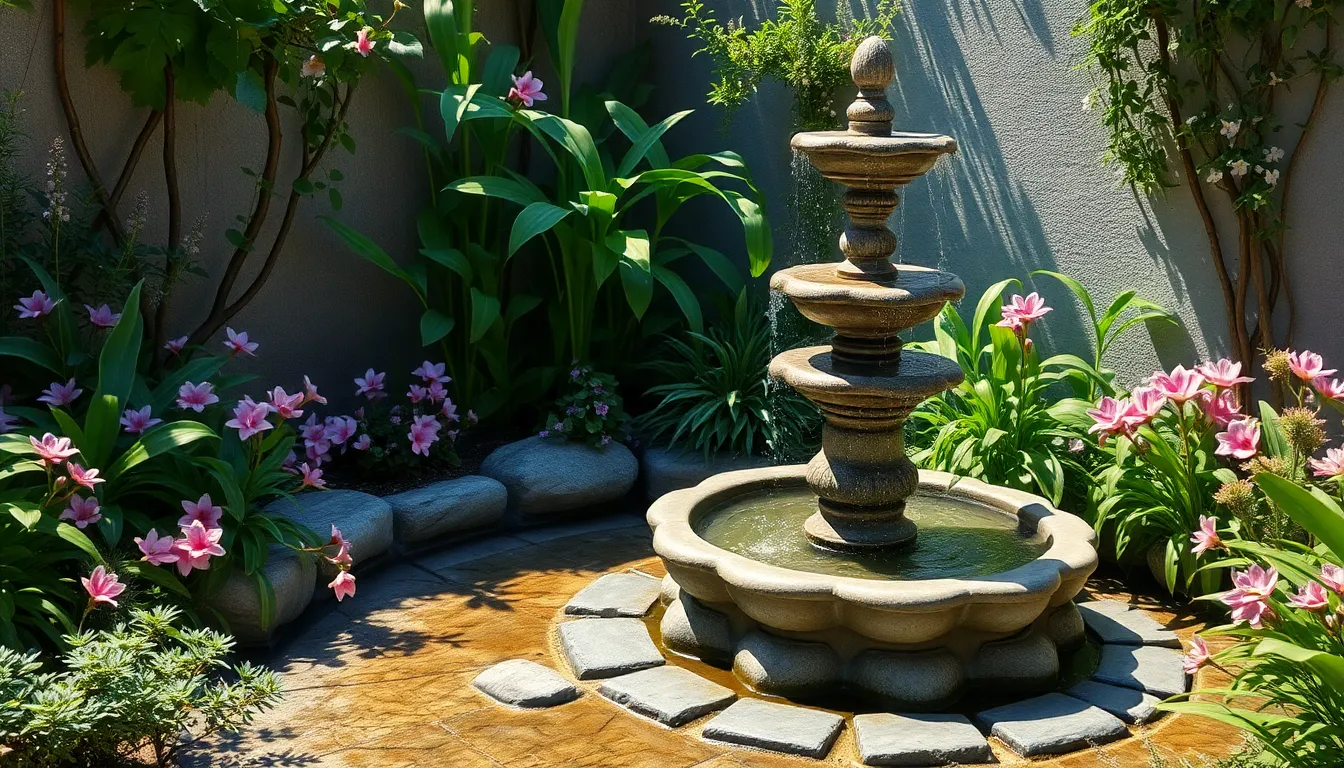
Water features transform neglected garden corners into captivating focal points that engage multiple senses. The gentle sounds of flowing water create a peaceful atmosphere while adding visual movement to static spaces.
Install a Small Corner Fountain
Corner fountains maximize impact in minimal space, making them perfect for tight garden areas. We recommend choosing compact models that measure 24-36 inches in diameter to fit snugly without overwhelming the corner space.
Tiered fountain designs create multiple water levels and enhance the soothing sound effects. Position your fountain on a stable base like concrete pavers or decorative stones to ensure proper drainage and prevent settling.
Electric fountains require GFCI-protected outlets within 6 feet of the installation site. Solar powered options eliminate electrical requirements while providing eco-friendly operation during daylight hours.
Build a Raised Pond With Aquatic Plants
Raised ponds offer easier maintenance access and create dramatic vertical interest in corner spaces. We suggest constructing walls 18-24 inches high using materials like natural stone blocks, concrete blocks, or composite lumber.
Aquatic plant combinations provide natural filtration and visual appeal throughout growing seasons. Include floating plants like water lilies and lotus, submerged oxygenators such as hornwort, and marginal plants like cattails or water iris around pond edges.
Pond liner installation requires careful attention to prevent leaks and ensure longevity. Use 45-mil EPDM rubber liners with protective underlayment, allowing 6-12 inches of overhang beyond the pond perimeter for secure anchoring.
Add Solar-Powered Water Elements
Solar water features operate independently without electrical connections, making corner installation simple and cost effective. Modern solar pumps generate sufficient flow rates for fountains up to 200 gallons per hour on sunny days.
Battery backup systems extend operation into evening hours and cloudy periods. We recommend models with lithium-ion batteries that store 6-8 hours of runtime for consistent water circulation.
Multiple solar elements can be combined for layered water displays in larger corner spaces. Consider pairing solar fountains with solar-powered pond aerators or small waterfalls to create comprehensive water feature ecosystems.
Create a Vertical Garden Paradise
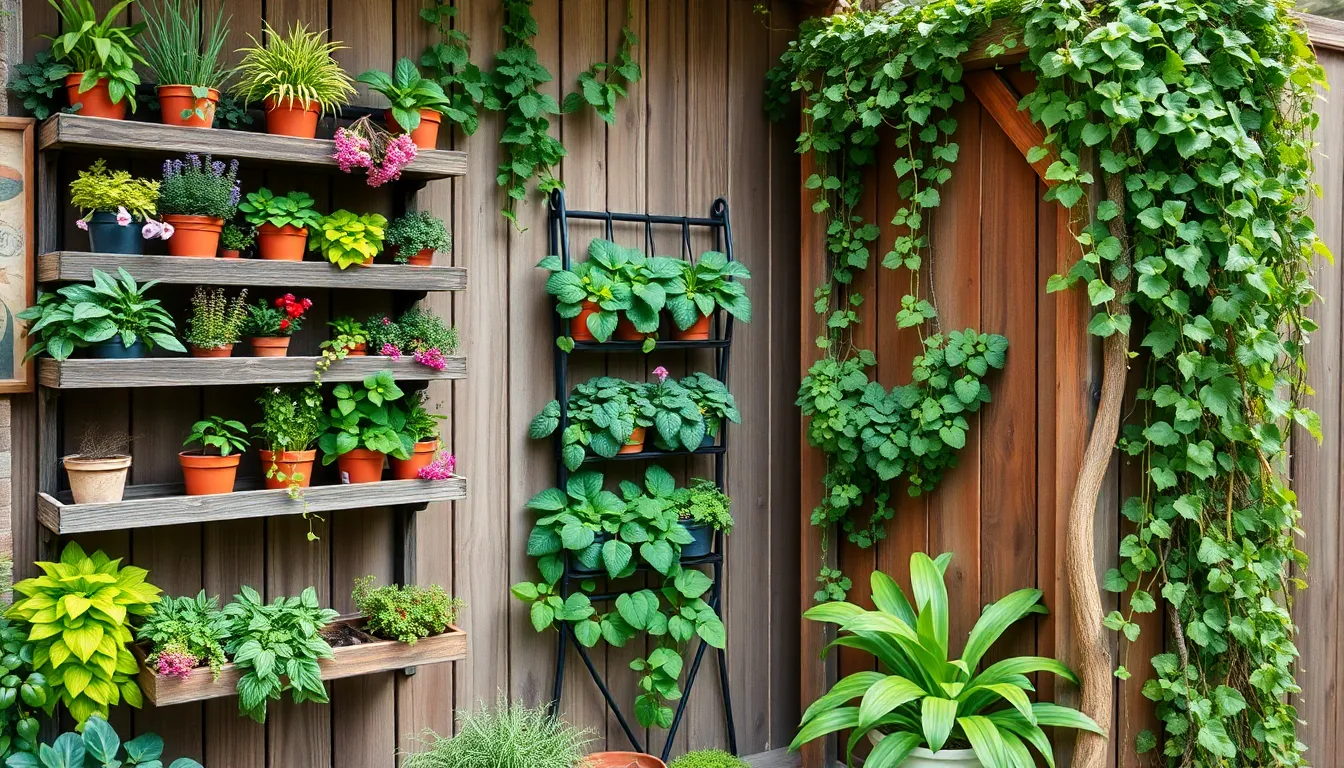
Vertical gardening transforms cramped corner spaces into lush, productive growing areas that maximize every square inch. We’ll explore three proven methods that deliver exceptional results while maintaining easy access for maintenance and harvesting.
Build Tiered Planting Shelves
Tiered shelves create stunning visual layers that showcase plants of varying heights, colors, and textures in one compact corner. We recommend using cedar or weather-resistant composite materials to construct 3-4 level shelving units that maximize vertical space while keeping plants accessible.
Different shelf depths accommodate various container sizes, from small herb pots on upper levels to larger vegetable containers on lower tiers. Herbs like basil and thyme thrive on upper shelves where they receive optimal sunlight, while leafy greens and flowers flourish on middle levels.
Strategic plant placement creates cascading effects when trailing varieties like sweet potato vines or petunias spill over shelf edges. We’ve found that staggering plant heights by shelf level creates ever-changing visual interest throughout the growing season.
Install Wall-Mounted Planters
Wall-mounted planters attach directly to corner fences or walls, keeping ground space clear while creating organized growing systems. We prefer modular pocket planters that hold multiple plants in one vertical unit, maximizing planting density without overwhelming the space.
Drainage systems become critical with wall-mounted installations since excess water can’t naturally flow away. We recommend planters with built-in drainage holes and water collection trays to protect surrounding surfaces.
Creative arrangements using different planter sizes and shapes turn plain walls into living art installations. Mixing geometric planters with organic curved designs adds visual texture while maintaining the garden’s overall aesthetic harmony.
Use Trellises for Climbing Vines
Trellises enable climbing plants to cover vertical surfaces quickly, transforming bare corner walls into lush green backdrops. We install sturdy wooden or metal trellises that support vigorous climbers like clematis, morning glory, and climbing roses throughout multiple growing seasons.
Privacy benefits emerge naturally as climbing vines mature and fill trellis spaces, creating intimate corner retreats. Fast-growing varieties like honeysuckle and jasmine provide quick coverage while offering seasonal flowers and pleasant fragrances.
Maintenance access remains simple when trellises are positioned 6-8 inches from walls, allowing air circulation and preventing moisture damage. We anchor trellis systems securely to handle wind loads and mature vine weight without compromising structural integrity.
Establish a Dedicated Herb Garden Space
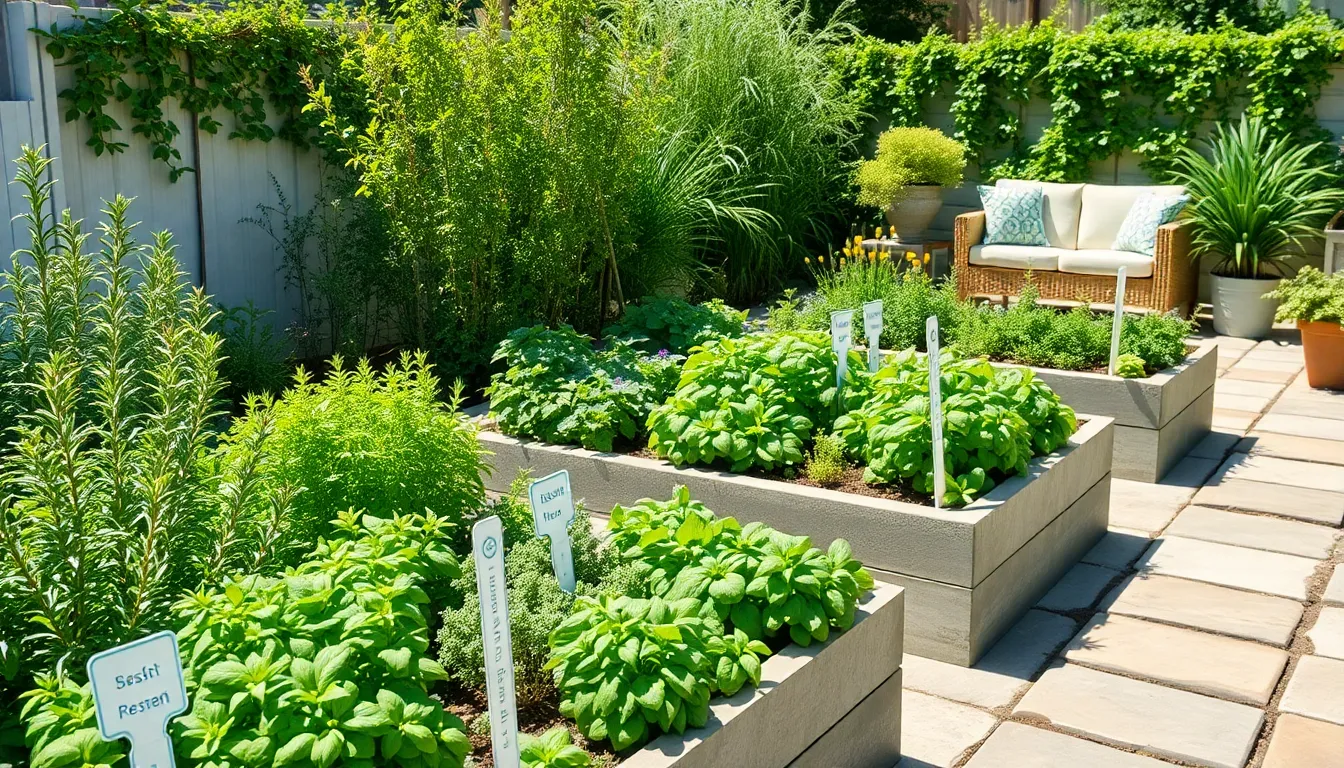
Creating a specialized herb corner transforms unused garden spaces into productive culinary destinations. We’ll maximize both functionality and visual appeal through strategic planning and thoughtful design choices.
Group Culinary Herbs by Sun Requirements
Mediterranean herbs like rosemary, thyme, and oregano thrive in full sun locations with well-draining soil. We position these sun-loving varieties along the southern or western edges of our corner space where they’ll receive 6-8 hours of direct sunlight daily.
Shade-tolerant herbs including parsley, chives, and mint flourish in areas receiving partial sun or filtered light. Cilantro and dill prefer cooler conditions and actually bolt less frequently when grown in morning sun with afternoon shade protection.
Basil varieties require warm, sheltered positions away from cold drafts but still need adequate light exposure. We create microclimates within our herb corner by using taller plants as natural windbreaks for more delicate species.
Design Raised Beds for Easy Access
Elevated planting areas improve drainage while reducing back strain during harvesting and maintenance tasks. We construct raised beds between 18-24 inches high using cedar, composite materials, or galvanized steel to ensure longevity and proper root development.
Corner-exact triangular or L-shaped bed designs maximize space utilization while creating natural pathways for easy movement. Standard rectangular beds measuring 4 feet wide allow us to reach the center from either side without stepping on soil.
Strategic placement of stepping stones or narrow paths between beds prevents soil compaction and maintains accessibility during wet weather. We incorporate built-in seating along bed edges to provide comfortable spots for detailed herb care and harvesting.
Add Labels for Garden Organization
Waterproof plant markers help identify individual herbs throughout their growing seasons and prevent accidental removal during garden maintenance. We use slate markers, metal tags, or cedar stakes with engraved information that won’t fade or deteriorate over time.
Color-coded labeling systems organize herbs by usage categories such as cooking, tea blends, or medicinal applications. Grouping related herbs visually simplifies meal planning and harvesting decisions during busy cooking periods.
Digital garden mapping apps complement physical labels by tracking planting dates, harvest schedules, and succession planting reminders. We photograph our labeled herb arrangements to reference plant locations during dormant seasons when many perennial herbs aren’t visible above ground.
Build a Charming Garden Shed Corner
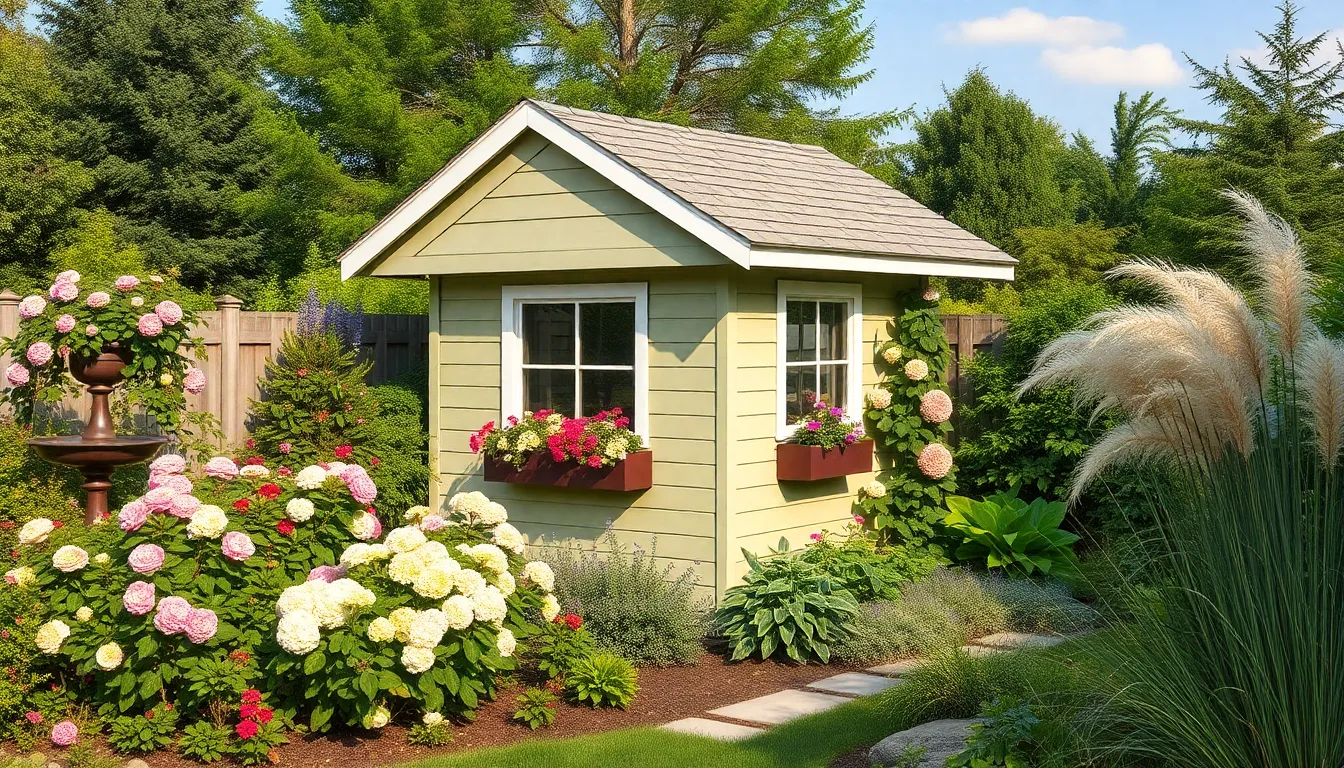
We can transform any neglected corner into a functional focal point by placing a small garden shed strategically. Sheds with architectural details, gabled roofs, or window boxes create visual appeal while maximizing yard space efficiently.
Choose Compact Storage Answers
Vertical shelving maximizes our storage potential without consuming valuable floor space in corner installations. Wall mounted tool racks keep equipment organized and easily accessible while maintaining a clutter free environment. Multi purpose furniture like storage benches serve dual functions by providing seating while concealing garden supplies inside.
Strategic placement of these compact answers allows us to maintain easy access to tools and materials. Stackable containers and modular shelving systems adapt to changing storage needs throughout different seasons. Corner exact storage units use awkward angles effectively while keeping frequently used items within arm’s reach.
Paint With Weather Resistant Colors
Bright, weather resistant paints protect our shed investment while improving its visual impact in the garden corner. Earthy greens blend seamlessly with natural surroundings and create a harmonious backdrop for plantings. Blues provide a cheerful contrast against foliage while maintaining a calming garden atmosphere.
Neutral tones like warm grays or soft beiges complement various landscaping styles without overwhelming nearby plants. Quality exterior paints with UV protection prevent fading and reduce maintenance requirements over time. Accent colors on trim or doors add personality while maintaining the overall design cohesion.
Surround With Complementary Plantings
Perennials like hydrangeas provide seasonal color while requiring minimal maintenance around our shed foundation. Shrubs create natural borders that soften the structure’s edges and integrate it into the industry design. Climbing plants such as roses or clematis add vertical interest while partially screening the building.
Ferns thrive in shaded areas behind sheds and contribute lush texture to corner plantings. Ornamental grasses provide movement and sound while establishing natural transitions between hardscape and garden beds. Low maintenance ground covers prevent weeds while creating attractive carpets around the shed’s base.
Layered plantings with varying heights create visual depth and seasonal interest throughout the year. Evergreen selections maintain structure during winter months while deciduous plants provide changing seasonal displays. Container gardens offer flexibility for rearranging color schemes and accommodating different plant requirements.
Develop a Butterfly and Pollinator Haven
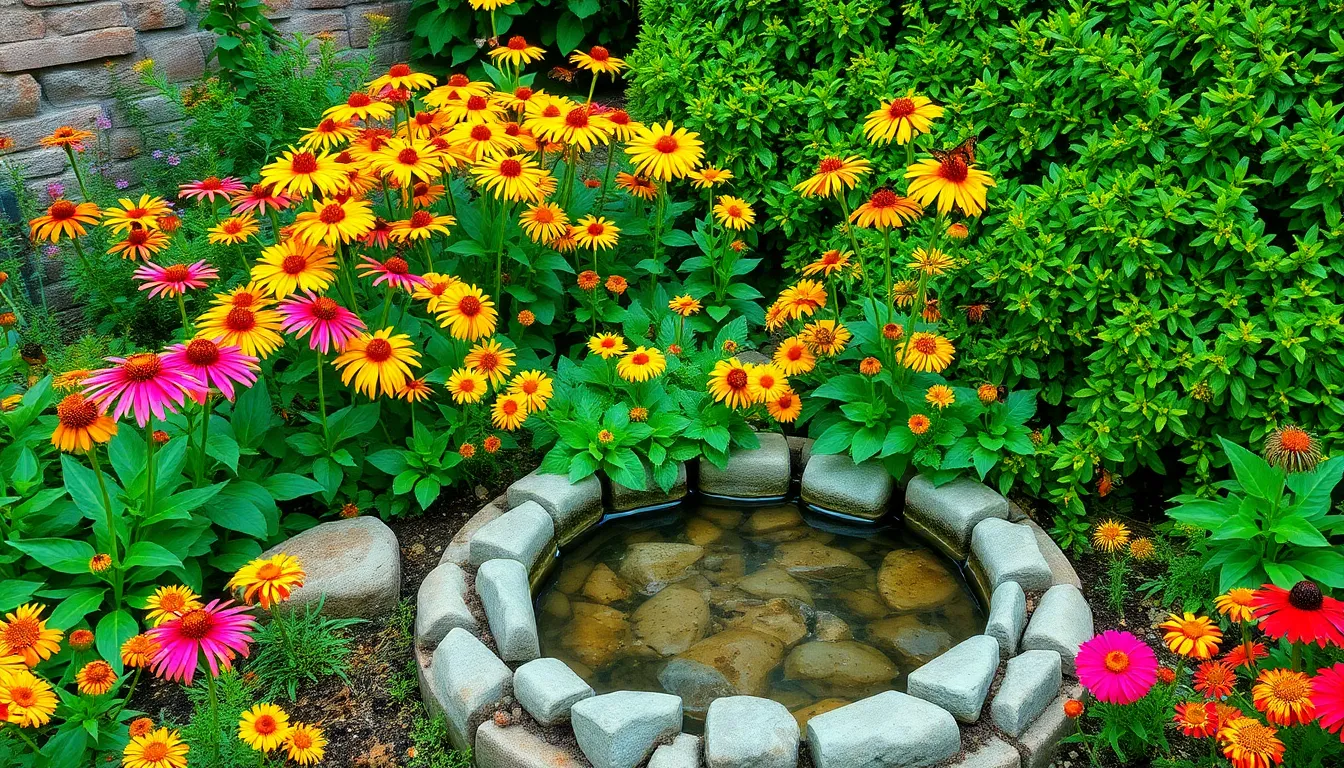
Transform your garden corner into a thriving network that supports butterflies, bees, and other beneficial insects while creating a beautiful focal point for your outdoor space.
Plant Native Flowering Species
Native flowering plants form the backbone of any successful pollinator garden, providing essential nectar and pollen throughout the growing season. We recommend using the proven 3 x 3 x 3 system by selecting three native species that bloom in spring, three for summer, and three for fall to ensure continuous food sources.
Different flower shapes and colors attract various pollinators to maximize your garden’s impact. Butterflies gravitate toward brightly colored, flat flowers like coneflowers and black eyed Susans, while bees prefer open, tubular shapes such as salvias and penstemons.
Grouping plants of the same species together creates visual impact and makes it easier for pollinators to locate their preferred food sources. We suggest planting in clusters of at least three to five plants rather than scattering individual specimens throughout your corner space.
Include Host Plants for Caterpillars
Host plants provide essential breeding grounds where butterflies can lay eggs and caterpillars can develop into adults. Milkweed stands as the most critical host plant for monarch butterflies, supporting their entire lifecycle from egg to adult butterfly.
Swallowtail butterflies benefit from a combination approach using both nectar plants and exact host plants in your corner design. Phlox, bee balm, and verbena supply nectar while curly parsley and fennel serve as caterpillar host plants for these stunning butterflies.
Creating designated areas for host plants ensures that your garden supports the complete butterfly lifecycle rather than just adult feeding. We recommend dedicating at least 30% of your pollinator corner to host plants for maximum breeding success.
Provide Water Sources and Shelter
Water features specifically designed for butterflies and pollinators differ significantly from traditional garden water elements. Shallow dishes or small puddles with fresh water provide drinking opportunities while rocks or twigs placed in the water create essential perches for smaller insects.
Natural shelter elements protect beneficial insects from harsh weather and predators throughout the seasons. Native shrubs or small trees offer wind protection and overnight roosting spots, while rock piles or logs provide warming areas during cooler mornings.
Strategic placement of shelter elements near your flowering plants creates a complete habitat system within your corner space. We suggest positioning larger shelter features like shrubs on the north side to prevent shading while placing smaller elements like rock piles in sunny spots where butterflies can bask and warm themselves.
Install a Fire Pit Entertainment Area
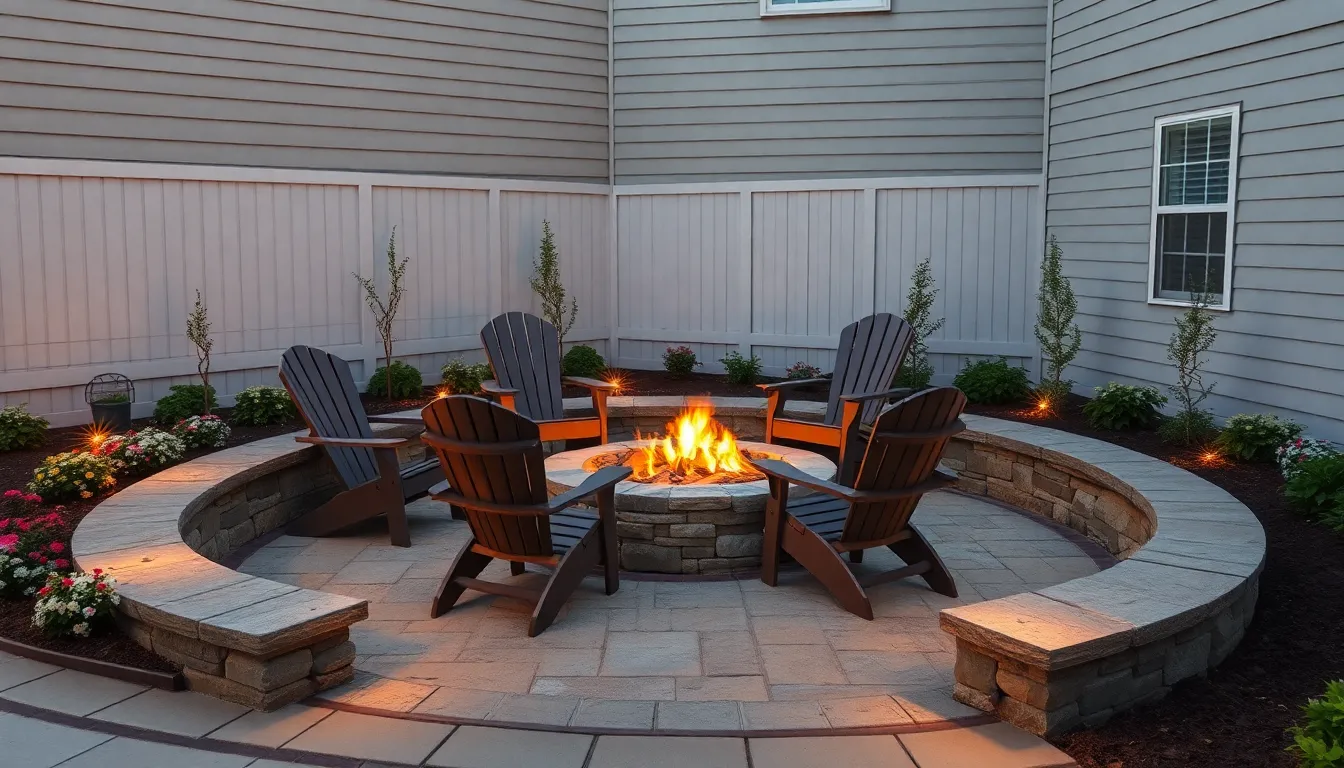
Transform your neglected garden corner into a cozy gathering spot that’ll become the heart of your outdoor entertaining. Corner fire pits create intimate spaces that encourage conversation while maximizing warmth distribution in compact areas.
Select Safe Fire Pit Materials
Choose fire pit materials that withstand high temperatures and outdoor conditions for long-lasting performance. Stone, metal, and concrete offer excellent durability while providing proper heat distribution throughout your corner space.
Stone fire pits deliver natural beauty and exceptional heat retention, making them ideal for extended evening gatherings. Metal options like steel and cast iron heat quickly and offer modern aesthetic appeal that complements contemporary garden designs. Concrete fire pits provide customizable shapes that fit perfectly into corner angles while maintaining structural integrity.
Avoid placing highly flammable materials near your fire pit to prevent safety hazards. Wood furniture, fabric cushions, and synthetic decorations should maintain safe distances from heat sources. Select designs that encourage complete combustion to minimize smoke production and maximize enjoyment.
Arrange Seating in Circular Formation
Position seats around your corner fire pit in circular or semicircular patterns to promote conversation and ensure equal warmth distribution. This arrangement creates natural gathering dynamics that bring people together while maximizing the corner’s unique geometry.
Adirondack chairs offer classic comfort and weather resistance for permanent seating answers. Built-in benches integrate seamlessly with corner designs while providing storage space underneath for fire tools and supplies. Movable garden seats maximize flexibility, allowing you to adjust configurations based on group sizes and seasonal needs.
Create conversation zones by spacing seats 3-4 feet from the fire pit to balance warmth with safety. L-shaped seating arrangements work particularly well in corner installations, utilizing both walls while maintaining open access paths. Consider adding ottomans or small side tables between chairs for drinks and snacks during gatherings.
Plan for Proper Ventilation and Safety
Position your fire pit in open corner areas with adequate clearance from walls, fences, and overhanging branches for proper air circulation. Maintain minimum distances of 10 feet from structures and 15 feet from tree canopies to prevent fire hazards and ensure smoke dispersal.
Install non-flammable ground surfaces like gravel, stone, or concrete pavers around your fire pit area. These materials prevent ember spread while creating defined boundaries for your entertainment space. Design drainage systems to prevent water accumulation that could damage fire pit foundations.
Keep fire safety equipment including water hoses, fire extinguishers, and sand buckets within easy reach of your seating area. Check local fire codes and obtain necessary permits before installation to ensure compliance with safety regulations. Establish clear evacuation routes and maintain these pathways free from obstacles or decorative elements.
Surround your fire pit area with raised flower beds or planters to integrate greenery while creating natural barriers. Add ambient lighting near seating areas for safe navigation during evening use and enhanced atmosphere. Use stepping stones or privacy screens to personalize your corner while maintaining safety clearances.
Create a Zen Meditation Garden

Transform your garden corner into a peaceful retreat that promotes calm and contemplation. This ancient design philosophy emphasizes simplicity and natural harmony to create the perfect space for mindfulness.
Use Gravel and Stone Elements
Gravel forms the foundation of our Zen meditation garden, providing both visual appeal and practical meditation benefits. We recommend using finely crushed gravel, small pebbles, or sand as the base material to create clean lines and minimize maintenance. Raking patterns into the gravel symbolizes water, ripples, or natural landscapes, which aids in mindfulness and meditation practice.
Large rocks serve as sculptural focal points that represent mountains or islands in traditional Zen design. Position these substantial stones first to form the foundation of your garden’s tranquility and provide compelling visual interest. The contrast between smooth gravel surfaces and textured rock formations creates the visual balance essential for contemplative spaces.
Strategic placement of stones in asymmetrical patterns mimics nature and evokes mystery, encouraging deeper reflection during meditation sessions. We suggest selecting rocks with interesting shapes and weathered surfaces that tell natural stories through their formations.
Add Minimalist Plant Selections
Plant choices should support the garden’s meditative atmosphere through simplicity and low maintenance requirements. We recommend compact varieties such as mosses, ferns, dwarf conifers, Japanese maples, or bamboo that won’t overwhelm the peaceful space. Limited plant selections maintain visual clarity and reduce distracting clutter that can interfere with contemplation.
Evergreen options like dwarf conifers provide year round structure while requiring minimal care. Japanese maples offer seasonal interest with their delicate foliage and graceful branching patterns. Bamboo creates gentle movement and soft sounds when touched by breezes, adding subtle sensory elements to the meditation experience.
Ground covering mosses establish living carpets that soften hard edges between stones and gravel. These resilient plants thrive in shaded areas and create the lush, ancient feeling associated with traditional temple gardens.
Include a Central Focal Point
Every Zen garden needs an anchor that draws the eye inward for contemplation and serves as a meditation focus. We suggest incorporating a distinctive rock formation, minimalist statue, or small water feature as your garden’s central element. This focal point should command attention while maintaining the overall sense of simplicity and balance.
Water features like small fountains or shallow basins add the soothing sound of moving water to enhance the meditative atmosphere. Stone lanterns or simple geometric sculptures provide visual weight without overwhelming the space’s natural tranquility.
Position your central feature where it can be viewed from multiple angles within the garden corner. The placement should feel natural and unforced, as if the element has always belonged in that exact location. This careful positioning creates the sense of harmony and balance essential for successful Zen garden design.
Design a Children’s Play Garden Corner
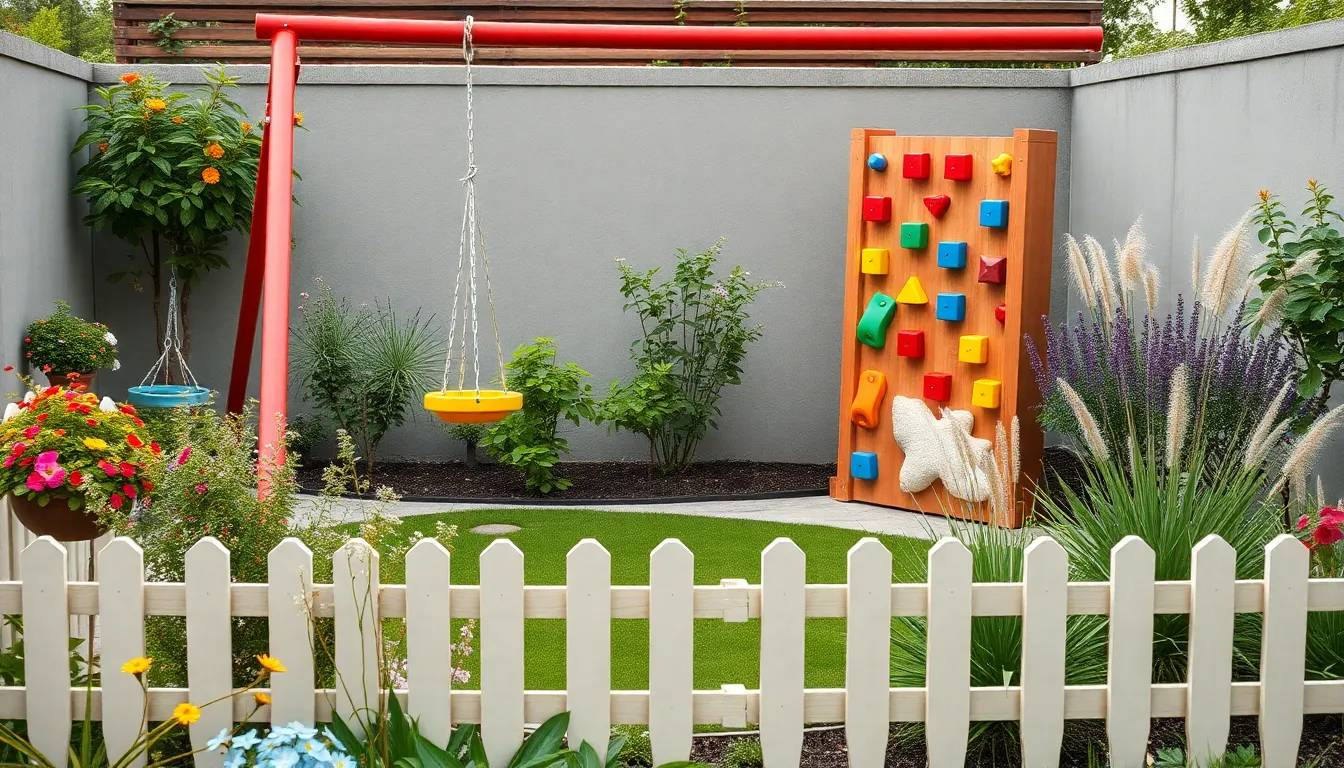
Transform that unused corner space into a magical playground where kids can explore, learn, and create lasting memories. A well-designed children’s play area combines safety features with captivating elements that spark imagination and encourage outdoor activity.
Install Safe Play Equipment
Choose age-appropriate equipment that matches your children’s developmental stages and interests. Swings work wonderfully for various ages, while slides and climbing walls challenge older kids safely. Compact climbing features fit perfectly on slopes or can be mounted to vertical panels in tight corner spaces.
Select durable, safe materials that withstand weather and heavy use. Gabion walls with climbing holds create an artistic feature that doubles as a challenging climbing surface. Wooden playhouses or teepees provide shelter and imaginative play opportunities.
Ensure proper ground cover beneath all equipment to minimize injury risks. Soft materials like rubber mulch, sand, or engineered wood chips create cushioned landing areas. Regular maintenance keeps equipment secure and surfaces level.
Consider multi-functional pieces that serve different purposes as children grow. A low climbing wall today becomes a garden backdrop tomorrow, while adjustable swings accommodate toddlers through teens.
Plant Child-Friendly, Non-Toxic Plants
Select completely non-toxic species that won’t harm curious children who might taste leaves or berries. Fruiting shrubs like blueberry bushes offer safe, edible rewards while teaching kids about growing food. Herbs such as mint, basil, and lavender engage multiple senses without posing safety risks.
Incorporate sensory-rich plantings that invite exploration and learning. Ornamental grasses rustle in breezes and feel interesting to touch, while textured plants like lamb’s ear provide tactile experiences. Espaliered fruit trees create living walls that children can watch change through seasons.
Include pollinator-friendly flowers that attract butterflies and bees for educational opportunities. Sunflowers, zinnias, and marigolds bloom reliably and help children understand nature’s interconnections. Native wildflowers support local ecosystems while creating colorful displays.
Create thematic garden borders using painted elements like colorful pencil fencing to add visual interest and educational value. These decorative boundaries help organize different plant zones while making the space feel uniquely designed for children.
Create Defined Boundaries for Safety
Install clear physical barriers that keep children safely contained within the play area. Fencing, decorative borders, or natural hedges prevent wandering into unsafe garden areas or toward roadways. Low picket fences work well for younger children, while taller options suit areas near busy streets.
Use raised beds and natural barriers to create distinct zones within the play space. These elevated plantings help define different activity areas while keeping children away from potentially hazardous garden tools or chemicals stored elsewhere.
Combine safety with learning elements by incorporating alphabet stepping stones or numbered pathways within the bounded area. These features reinforce educational concepts while clearly marking safe walking paths throughout the play corner.
Design sight lines that allow easy supervision from house windows or outdoor seating areas. Parents need clear views of the entire play space to monitor activities safely. Strategic placement of taller plants creates privacy without blocking important supervision angles.
Establish a Seasonal Display Garden
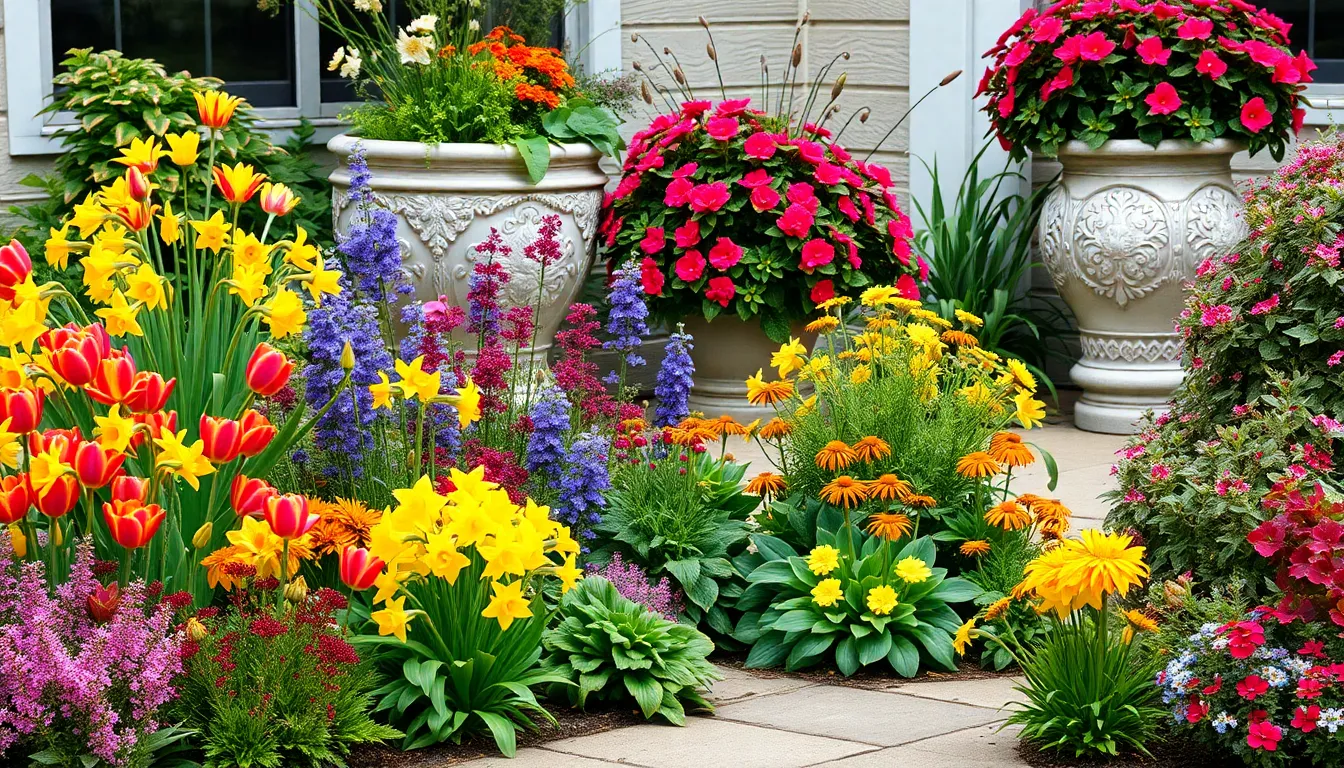
Creating a corner that transforms throughout the year keeps your garden visually captivating and provides continuous interest. Seasonal displays maximize the beauty of every month while ensuring you’ll always have something spectacular to admire.
Rotate Plants Throughout the Year
Rotating plants based on seasonal cycles transforms your corner garden into a ever-changing showcase that never becomes stagnant. Spring flowering bulbs like tulips and daffodils create the foundation for early season color, while summer perennials such as lavender and coneflowers maintain vibrant displays during warmer months.
Autumn brings opportunities to introduce fall foliage plants like Burning Bush, which provides stunning red and orange leaves that contrast beautifully with evergreen backdrop plants. Winter doesn’t mean your corner goes dormant when you incorporate plants with winter berries or interesting bark textures.
Strategic timing ensures your corner maintains visual appeal throughout seasonal transitions. We recommend planning plant rotations three months in advance, allowing time for proper soil preparation and plant establishment before their peak display periods.
Use Containers for Easy Changes
Large containers serve as versatile focal points that allow for quick seasonal updates without disturbing permanent plantings. Container gardening provides flexibility to experiment with different plant combinations and instantly refresh your corner’s appearance.
Multi-season interest plants like Amelanchier lamarkii work exceptionally well in containers, offering spring flowers, summer berries, and brilliant autumn foliage all from a single specimen. These plants provide continuous value while requiring minimal container changes throughout the year.
Container sizing matters for successful seasonal displays, with larger pots maintaining better soil moisture and supporting more substantial plant growth. We suggest using containers at least 18 inches in diameter to accommodate root systems and reduce watering frequency during hot summer months.
Plan Color Schemes by Season
Spring color palettes featuring soft blues and purples create gentle transitions from winter’s muted tones to summer’s vibrant displays. Early flowering plants like Hellebores and spring bulbs establish these delicate color foundations that complement emerging foliage.
Summer schemes embrace radiant oranges and yellows that reflect the season’s energy and abundant sunshine. Bold perennials and annual flowers in these warm tones create striking focal points that draw attention from across the garden.
Autumn transitions into deep reds and golds that echo falling leaves and harvest themes, while winter color schemes rely on rich browns combined with bright winter berries from plants like Winterberry Holly. These seasonal color progressions create natural flow and prevent jarring transitions between planting periods.
Conclusion
We’ve explored many ways to transform those forgotten garden corners into vibrant and purposeful spaces. From tranquil reading nooks to butterfly havens each solution addresses different needs while maximizing your garden’s potential.
The key to success lies in matching your chosen design to your corner’s exact conditions and your lifestyle needs. Whether you’re drawn to the meditative qualities of a Zen garden or the practical benefits of an herb corner there’s an option that’ll work perfectly for your space.
Remember that corner gardens offer unique opportunities for creativity and experimentation. These intimate spaces allow you to try bold design choices that might feel overwhelming in larger garden areas making them perfect testing grounds for new ideas and plant combinations.
Frequently Asked Questions
What are the best plants for shady garden corners?
For shady corners, choose plants that thrive in low-light conditions. Ferns, hostas, and astilbe work beautifully for ground cover and mid-level plantings. Climbing vines like ivy or Virginia creeper can add vertical interest. Mosses and shade-tolerant ornamental grasses create texture, while flowering options include begonias, impatiens, and caladiums for seasonal color.
How do I create privacy in a corner reading nook?
Use screening plants like bamboo, tall ornamental grasses, or evergreen shrubs to create natural barriers. Install climbing vines on trellises or fences for vertical privacy. Strategic placement of large potted plants can also block sightlines. Consider lattice panels with climbing roses or jasmine for both privacy and fragrance in your cozy corner retreat.
What type of seating works best for outdoor corner spaces?
Weather-resistant materials are essential for outdoor seating. Teak benches offer natural durability, while aluminum frames resist rust and corrosion. Synthetic resin wicker provides comfort and weather resistance. Storage benches add functionality by hiding garden tools or cushions. Concrete seating with built-in planters combines durability with integrated garden design elements.
How much space do I need for a corner water feature?
Small corner fountains can fit in spaces as compact as 2×2 feet, making them perfect for tight corners. Wall-mounted fountains require minimal floor space while maximizing vertical impact. Raised ponds typically need 4×4 feet minimum for proper aquatic plant growth and fish habitat. Consider your corner’s dimensions and choose features that complement rather than overwhelm the space.
What safety considerations are important for children’s garden corners?
Install proper ground cover like rubber mulch or sand to cushion falls. Choose age-appropriate, rounded-edge equipment without sharp corners. Create defined boundaries using low fencing or raised beds to contain play areas. Select non-toxic plants and avoid those with thorns, berries, or poisonous leaves. Ensure clear sightlines for adult supervision from nearby areas.
How do I maintain year-round interest in corner gardens?
Plan for seasonal rotation using large containers that can be easily swapped out. Include evergreen plants as a backbone for winter structure. Layer spring bulbs, summer annuals, fall foliage plants, and winter berry-producing shrubs. Use ornamental grasses and plants with interesting bark or seed heads that provide texture during dormant seasons.
What’s the best way to light a corner garden space?
Solar string lights provide ambient lighting without electrical work and charge automatically during the day. Battery-powered LED lanterns offer portable, flexible lighting options. For permanent installations, consider low-voltage landscape lighting with timers. Place lights to highlight key features like water elements, seating areas, or specimen plants while avoiding harsh, direct illumination.
How do I choose plants for a pollinator corner garden?
Select native flowering species that bloom throughout the growing season to provide continuous food sources. Include a variety of flower shapes and sizes to attract different pollinators. Plant in clusters rather than single specimens for maximum impact. Consider butterfly host plants like milkweed alongside nectar sources. Avoid pesticides and choose plants with different bloom times for sustained activity.

